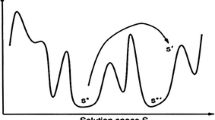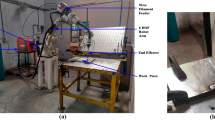Abstract
This study proposes an effective means of applying a neural network approach to parameter optimization for a multi-response problem. No matter what type of experimental designs are being employed, the proposed approach can be directly applied. In addition, the design factors with level settings or with continuous values can be also solved with the proposed approach. Not only can parameter optimization be achieved, but the effects of the control factors reacting on a multi-response system can also be simultaneously determined. An illustrative example given courtesy of a lead frame manufacturer in Taiwan is employed to demonstrate the effectiveness of the proposed approach .
Similar content being viewed by others
References
Ames AE, Mattucci N, Macdonald S, Szonyi G, Hawkins DM (1997) Quality loss functions for optimization across multiple responses surface. J Qual Technol 29(3):339–346
Castillo ED, Montgomery DC, McCarville DR (1996) Modified desirability functions for multiple response optimization. J Qual Technol 28(3):337–345
Chapman RE (1995–1996) Photochemistry multiple response co-optimization. Qual Eng 8(1):31–45
Cybenko G (1989) Approximation by superposition of a sigmoidal function. Math Control Signal System 2:303–314
Derringer G, Suich R (1980) Simultaneous optimization of several response variables. J Qual Technol 12(4):214–219
Fowlkes WY, Creveling CM (1995) Engineering methods for robust product design: using Taguchi methods in technology and product development. Addison-Wesley, Boston
Johnson RA, Wichern DW (1992) Applied multivariate statistical analysis. Prentice-Hall, New York
Khuri AI, Conlon M (1981) Simultaneous optimization of multiple responses represented by polynomial regression functions. Technometrics 23:363–375
Lai Y-J, Chang TH (1994) A fuzzy approach for multiresponse optimization: an off-line quality engineering problem. Fuzzy Set Syst 63:117–129
Layne KL (1995) Methods to determine optimum factor levels for multiple response in designed experimentation. Qual Eng 7(4):649–656
Leon NA (1996–1997) A pragmatic approach to multiple-response problem using loss function. Qual Eng 9(2):213–220
Logothetis N, Haigh A (1988) Characterizing and optimizing multi-response processes by the Taguchi method. Qual Reliab Eng Int 4:159–169
Montgomery DC (1991) Design and analysis of experiments. Wiley, New York
Myers RH, Montgomery DC (1995) Response surface methodology. Wiley, New York
NeuralWare, Inc. (1990) NeuralWorks Professional II/Plus and NeuralWorks Exporer. NeuralWare, Carnegie
Peace GS (1993) Taguchi methods: a hands-on approach. Addison-Wesley, Boston
Phadke MS (1989) Quality engineering using robust design. Prentice-Hall, New York
Pignatiello JJ Jr. (1993) Strategies for robust multi-response quality engineering. IIE Trans 25:5–15
Rumelhart DE, Hinton GE, Williams RJ (1986) Learning internal representations by error propagation. In: Rumelhart DE, McClelland JL (eds.) Parallel distribution processing: explorations in microstructure of cognition. MIT Press, Cambridge, pp 318–362
Su C-T, Heish K-L (1998) Applying neural networks to achieve robust design for dynamic quality characteristics. Int J Qual Reliab Manage 15(4–5):509–519
Su C-T, Tong L-I (1997) Multi-response robust design by principal component analysis. Total Qual Manage 8(6):409–416
Taguchi G (1966) Statistical analysis (in Japanese). Maruzen, Tokyo
Tong L-I, Hsieh K-L (2001) Optimization of multiple quality responses involving qualitative and quantitative characteristics in IC manufacturing using artificial neural networks. Comput Ind 46(1):1–12
Tong L-I, Su C-T (1997) Optimizing multi-response problems in the Taguchi method by fuzzy multiple attribute decision making. Qual Reliab Eng Int 13:25–34
Tong L-I, Su C-T, Wang C-H (1997) The optimization of multi-response problems in Taguchi method. Int J Qual Reliab Manage 14(4):367–380
Author information
Authors and Affiliations
Corresponding author
Rights and permissions
About this article
Cite this article
Hsieh, KL. Parameter optimization of a multi-response process for lead frame manufacturing by employing artificial neural networks. Int J Adv Manuf Technol 28, 584–591 (2006). https://doi.org/10.1007/s00170-004-2383-1
Received:
Accepted:
Published:
Issue Date:
DOI: https://doi.org/10.1007/s00170-004-2383-1




